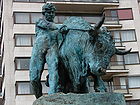
Léon Mignon
Encyclopedia

Realism (arts)
Realism in the visual arts and literature refers to the general attempt to depict subjects "in accordance with secular, empirical rules", as they are considered to exist in third person objective reality, without embellishment or interpretation...
idiom, known for his depiction of bull
Bull
Bull usually refers to an uncastrated adult male bovine.Bull may also refer to:-Entertainment:* Bull , an original show on the TNT Network* "Bull" , an episode of television series CSI: Crime Scene Investigation...
s.
Born at Liège, Léon Mignon completed his studies at the Académie royale des Beaux-Arts de Liège in 1871. He made his first showing at the Salon of Ghent, and obtained a fellowship from the Fondation Darchis for further study in Italy.
He set up his studio in Paris
Paris
Paris is the capital and largest city in France, situated on the river Seine, in northern France, at the heart of the Île-de-France region...
in 1876 in collaboration with Paul de Vigne
Paul de Vigne
Paul de Vigne , Belgian sculptor, was born at Ghent. He was trained by his father, a statuary, and began by exhibiting his Fra Angeico da Fiesole at the Ghent Salon in 1868. In 1872 he exhibited at the Brussels Salon a marble statue, Heliotrope , and in 1875, at Brussels, Beatrix and Domenica...
, then settled permanently at Schaerbeek. He won a gold medal at the Paris Salon for his sculpture Li Tore, the Bull-Tamer (illustration) which provoked polemics from critics for its combination of nudity with forthright realism.
Li Tore, set up at Liège, became the mascot of the students, who hid it in the cellars of the Académie to protect it during World War II
World War II
World War II, or the Second World War , was a global conflict lasting from 1939 to 1945, involving most of the world's nations—including all of the great powers—eventually forming two opposing military alliances: the Allies and the Axis...
. The bull has become an emblem
Emblem
An emblem is a pictorial image, abstract or representational, that epitomizes a concept — e.g., a moral truth, or an allegory — or that represents a person, such as a king or saint.-Distinction: emblem and symbol:...
for all Liège, with the city motto "Liège, forcer l’avenir!", "Liège, make the future happen!"
A bronze on a similar theme, his Le Dompteur de Taureaux (1881), which had been noticed at the retrospective exhibition of Belgian sculpture the previous year (in its plaster model), and was championed by Gustave Rolin-Jaequemyns, Minister of the Interior, stands on the Terrasses d'Avroy, Liège. Though a scarf had been added to the model to disguise the figure's nudity, the sculpture scandalised the editors of the Catholic daily, La Gazette de Liège.
One among his animalier
Animalier
An animalier is an artist, mainly from the 19th century, who specializes in, or is known for, skill in the realistic portrayal of animals. "Animal painter" is the more general term for earlier artists...
sculptures is to be seen at the Botanical Garden of Brussels
Botanical Garden of Brussels
The Botanical Garden of Brussels stands on Rue Royale, near the Northern Quarter financial district in Brussels.Originally founded in 1826 and partly designed by architect Tilman-François Suys, the main orangery is composed of a central rotunda with a dome, and two side aisles with windows at the...
: The Olive Tree, or Peace, representing an agricultural worker with his ox. His early Combat de taureaux dans la campagne romaine is conserved in the Musée Royal des Beaux-Arts, Brussels.
Other sculptures include Hide-and-Seek and Lady Godiva.
Both Schaerbeek and Liège possess a rue Léon Mignon.

